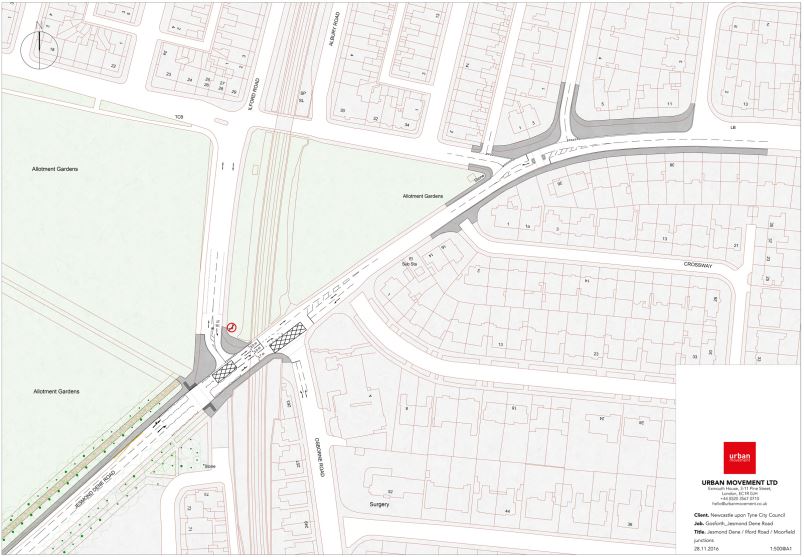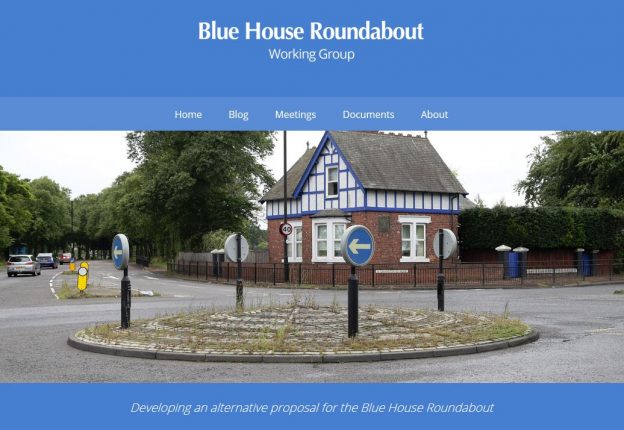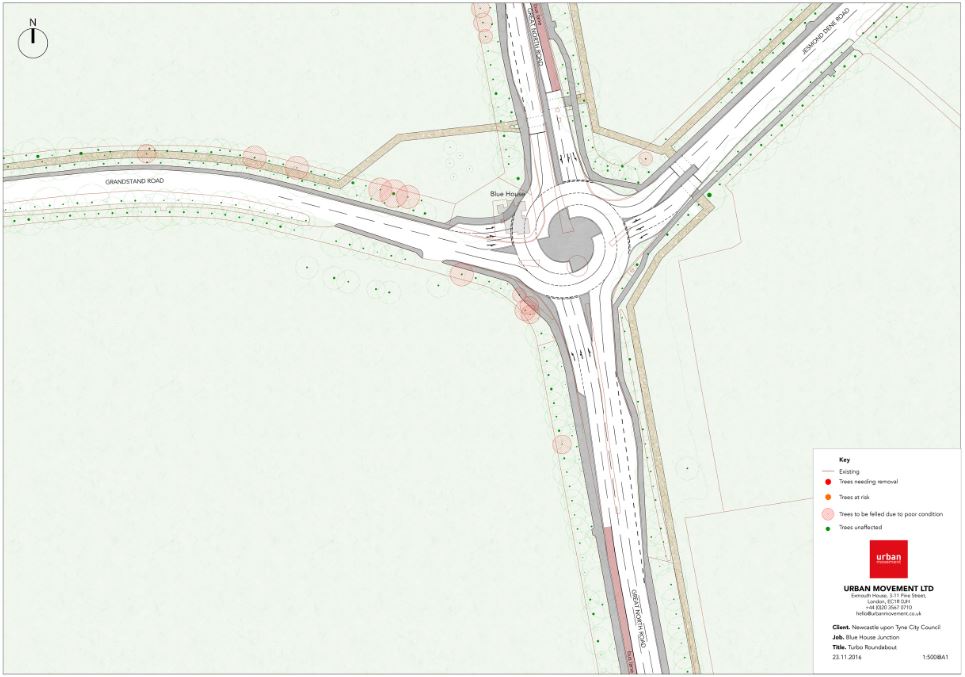The Blue House and Jesmond Dene Road Working group met on Monday 28th November. The notes from the meeting have been uploaded to the working group’s website.
This was our fifth meeting so here’s a quick recap of what we’ve covered already (not in any particular order or priority).
From an education and understanding perspective, we’ve learnt about:
- City Council policies and how they must be used to influence the design
- The mechanisms for funding transport plans
- Data covering collisions, the health of trees, historical traffic volumes, impact of restricting turns
- 5 Alternative Plans
- Proposals to reduce speed limits along the whole of the Great North Road
- An assessment framework to measure a successful outcome and support design
- Methods used in forecasting traffic volumes and queue lengths
- The impact of restricting vehicle movements
At our fifth meeting the proposed speed limit changes for the whole stretch of Great North Road (which will be taken to public consultation shortly but are a mixture of 40mph on open spaces reducing to 20mph in built up areas) were covered, and the traffic modelling data for the previous designs was explained and reviewed. The challenge with traffic modelling data is that it’s only modelling around the junction and therefore works in isolation. Graham Grant, Head of Transport Investment confirmed that the council engineers do model for the network and that this exercise would be undertaken when the Working Group had finalised its preferred alternative plan. However, as the three plans had already been largely rejected for a variety of reasons the presentation of this modelling data was more an educational exercise.
John Dales presented a new design which extended the concept of the ‘turbo’ roundabout, discussed at a previous meeting.
Turbo roundabouts were first introduced in Holland in 2000, and there are now 300 in operation across the country. The Dutch Institute of Road Safety Research (SWOV) describes a turbo roundabout as:
This roundabout has non-concentric markings, which makes it possible to exit a two-lane roundabout without the risk of lateral conflicts i.e. situations in which vehicle sides can touch one another. In essence, a turbo-roundabout has the following features:–
- no weaving takes place on the roundabout;
- traffic entering the roundabout has to give way to traffic on two lanes;
- each segment has one single lane on which traffic can choose whether or not to leave the
- roundabout.
The first turbo roundabout in the UK was implemented in Bedford in 2014. It was disliked by cycling campaigners as there was no separated space. However at Blue House, cycle lanes can be accomodated away from the main carraigeway.
 Turbo Roundabout – Bedford (click on image for Streetview)
Turbo Roundabout – Bedford (click on image for Streetview)
The new design extends the turbo design from a previous plan and intrudes into the Moor space by using space currently occupied by the Blue House itself.
The Blue House is not registered as a Building of Special Architectural or Historic Interest, however it does appear as a local listed building in Newcastle City Council’s Supplementary Planning Document (“the SPD”) for the Newcastle upon Tyne Local List adopted on 21 September 2006. “The SPD encourages the retention and conservation of the City’s local heritage assets.”
The Working Group was again split up into smaller groups to comment on the following alternative design:
Blue House Roundabout Alternative Design – ‘Turbo Roundabout’ (click on image for pdf)
This design maintains the current volume of vehicle lanes but through the use of a staggered roundabout introduces greater lane discipline and reduces vehicle speed. The red circles are trees that are unhealthy, end of life, or dangerous and have been identified by research undertaken by arboriculturalists. The light brown lines that run parallel to the roads are footpath/cycle track. The traffic modelling data for this roundabout will be provided at the next meeting.
SPACE raised the following of points on this design:
- For people walking or cycling the crossing points are two phase, resulting in people being forced to wait in the middle of the road when crossing
- There are no crossings to the south or west of the junction for people walking or cycling
- The extension of the north bound bus lane beyond Forsyth Road is welcomed
- Making use of the existing gravel road on the Town Moor (west of Great North Road) for a footway/cycle track is welcomed
- There is no long term provision for buses travelling east west
- The demolition of Blue House may have an impact on visual intrusion on the Moor
- The design of pathway/cycle track away from the road is welcomed.
It should be borne in mind that this plan is another proposed plan and the Working Group is free to make modifications. Any proposed design will likely go through several iterations of refinement.
For the first time, the Working Group considered Jesmond Dene Road heading towards Haddricks Mill. The junction at the top of Osborne Road has restricted space due to the width of the Metro bridge.
 Jesmond Dene Road Alternative Design (click on image for pdf)
Jesmond Dene Road Alternative Design (click on image for pdf)
SPACE made the following observations on this design:
- The provision of a crossing at the top of Osborne Road is welcomed
- The footpath/cycle track terminates at Ilford Road
- There is no provision for people cycling beyond Ilford Road
- SPACE proposed that there was sufficient space on Ilford Road and Moorfield (East) to provide protected cycle lanes
- A potential area of conflict between vehicles and cycles is the junction on Moorfield (East) and Jesmond Dene Road
- There is potential for rat running (by-passing Blue House roundabout) where vehicles use the residential street Moorfield joining at the lights with Jesmond Dene Road
- A ‘No Entry’ from Jesmond Dene Road onto Moorfield would resolve the potential for rat running and minimise conflict between people cycling and vehicles
- A ‘No Entry’ on Moorfield would increase safety for residents
- The plan needs to consider how people cycling could travel between High West Jesmond and West Jesmond (the path alongside La Sagesse was suggested as a compromise)
- The Ilford Road and Moorfield junction needs to be reviewed in conjunction with other changes
- The siting of the pedestrian crossing between Moorfield and Beatty Avenue is welcomed.
Another productive and thought provoking meeting. We’ve certainly come a long way in a relatively short time!
The next meeting will take place on Monday 12th December 2016.
If you have any questions or comments, you can email SPACE at spaceforgosforth@gmail.com, leave comment on this post, make comment on our Facebook page or add comment to the bluehousegroup.org posts.



Just some thoughts on the layouts as outlined (without access to all relevant info) and based upon my support for a smaller footprint solution to the problem as opposed to the previously NCC published and consulted upon! Mega roundabout option:
I disagree with the extension of the northbound GNR bus lane. This will exacerbate the problem of single lines of traffic queuing, with or without increased traffic numbers. In addition as it currently stands without this extension, there is no impact/very minimal on throughput of buses through the BHR junction. Also my experience of peak pm time here is that there is more northbound GNR to Jesmond Dene Rd traffic than that going straight up the GNR, yet this scheme suggests only 1 lane for this particular turn.
Also the two lanes from the roundabout onto Jesmond Dene Rd appear to merge into one then back into two. Which is right? Also whilst you have indicated two lanes eastbound, there are also currently two informal lanes westbound from the Ilford Rd junction along Jesmond Dene Rd to BHR. Hopefully an enforced ‘yellow box’ at this junction will ensure clear right turns from Jesmond Dene Rd onto Ilford Rd.
What has happened to the GNR Bus lane north of BHR? If it is to remain as is just north of the bus stop, then the suggested Toucan crossing is located directly upon the 2 lanes into 1 merging area. This will not work and if fact would place crossing pedestrians and cyclists and other motorists at risk from ‘racing’ vehicles keen to either get through the red light or get across lanes asap after the crossing. Two lanes turning left from Grandstand Rd onto the GHR also add to this issue. The same situation could potentially occur eastbound onto Jesmond Dene Rd with an as indicated two lanes merging into one immediately after the Toucan crossing.
Will the proposed carriageway widths be able to safely allow continued on road cyclist movements? We have seen and are seeing too many schemes locally which whilst providing off road space for cyclists, albeit reducing the amount for pedestrians, reduce the carriageway width to such an extent they place cyclists in particular and motorists at increased risk. Shouldn’t we be proposing just one solution for cyclists that works for everyone of all ages and abilities, without of course resorting to the previous NCC mega roundabout scheme? Also what happens to the existing shared surface paths around this junction? Do they revert back to pedestrian only?
And in relation to this and in particular with reference to the plan key indicating that the vast majority of trees alongside each road are ‘unaffected’, can I say that building presumably to surrounding ground level, a 3m wide? cyclepath through the middle of a narrow avenue of mature trees, will affect each and every tree. The number of ribbons currently in place would need to quadrupled if what is suggested on this scheme goes ahead, because whilst they won’t immediately die, a large percentage of their roots will be cut and removed, thereby affecting their continued growth and also increasing massively the possibility of death and/or being blown over or simply falling over. The narrower 1m wide paths on the south sides of both Grandstand and Jesmond Dene Rd have had a small effect on adjacent trees through limiting growth, but it is nothing compared to what is currently being suggested. One of the main reason for the recent opposition to the mega roundabout was its impact on the landscape of the Town Moor. Elements of the current scheme potentially do just the same.
One of the main ongoing issues with the supposed ‘traffic improvements’ schemes across Gosforth has been the poor standard of drawings with important information missed, drawings not accurately leading into the next, as well as the deliberate exclusion of information which would ordinarily be important when consulting on a supposed detailed, worked up scheme. Please do not fall into the same trap and please ensure that the drawings are as accurate as possible with as much detail as possible given the scale and text limitations.
Lastly in relation to the Blue House, this can simply be lifted and moved further back into the new corner behind.
On a final note, of those groups attending the Working Group, am I correct in thinking that New Cycling is in fact one and the same as Newcastle Cycling Campaign and therefore the reference to one or the other should be removed?